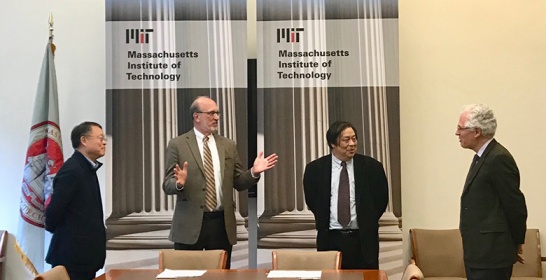NRL Collaboration with the Chinese Academy of Sciences
Signing the agreement to extend. Dr. Mianheng Jiang, President, ShanghaiTech University; Dr. David Moncton, Director, MIT Nuclear Reactor Laboratory; Dr. Hongjie Xu, Director, Thorium Molten Salt Reactor Center, SINAP; and Professor Richard Lester, MIT Associate Provost for International Activities.
The Massachusetts Institute of Technology (MIT) and the Shanghai Institute of Applied Physics (SINAP) have agreed to extend through December 31, 2020 a collaborative research agreement which began on October 1, 2015. Following the successful completion of the four tasks to advance the technologies needed to realize a new class of fluoride-salt-based high-temperature reactors, undertaken under the original agreement for $2.1M, a second set of four tasks has been agreed upon for the continuing collaboration at a funding level of $1.5M.
The first of the new tasks integrates reactor simulation, operation, and measurement to support the development of a demonstration Molten Salt Reactor (MSR). Several SINAP researchers will participate in MIT Reactor (MITR) operation and lectures similar to those provided to reactor operator training and MIT nuclear technology professional courses. To advance the engineering design of an MSR, an MIT Reactor (MITR) simulator will be developed to incorporate neutronic and thermal hydraulic models and instrumentation and control modules to model both steady-state and transient responses to provide a useful simulation tool for integrated reactor engineering system validation. Measurements will be performed on the MIT Graphite Exponential Pile (MGEP) to evaluate new nuclear graphite thermal neutron scattering libraries. The MIT Principal Investigator for this project is Dr. Lin-wen Hu with Dr. Kaichao Sun as co-Principal Investigator.
The second activity is to perform the post irradiation examination of graphite materials irradiated in high-temperature FLiBe salt in the MITR. The goal of this work is to understand the combined effects of high-temperature molten salt and neutron irradiation on graphite materials and C/C composite on microstructures and thermal and mechanical properties of these materials. The MIT Principal Investigator for this project is Dr. Lin-wen Hu with Dr. David Carpenter as co-Principal Investigator.
The third project addresses one of the major technical challenges for salt-cooled reactors, namely avoiding the release of tritium to the environment, and corrosion of internal components. Tritium is generated in the salt coolant. The goal is to have an integrated knowledge of tritium behavior in the system, models of tritium transport, and the ability to predict tritium behavior in different forms of graphite. Graphite is compatible with liquid salts at high temperatures and tritium adsorbs on graphite in the reactor core. Understanding tritium and graphite is required to understand tritium transport in the reactor and graphite can be used for tritium removal from salt to prevent tritium releases to the environment. The MIT Principal Investigator for this project is Dr. Charles Forsberg of MIT's Nuclear Science and Engineering Department.
And finally the last of the new tasks is on developing hybrid energy systems and heat storage for variable electricity to the grid and variable heat to industry while the salt reactor operates at full power. Salt reactors produce high-temperature heat that matches industrial head demand. Heat storage enables operating at base-load to minimize reactor costs while variable electricity to the grid maximizes electricity revenue and minimizes the cost of industrial heat. The MIT Principal Investigator for this project is Dr. Charles Forsberg of MIT's Nuclear Science and Engineering Department.

